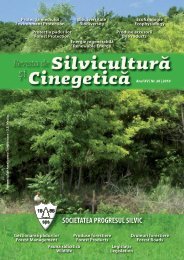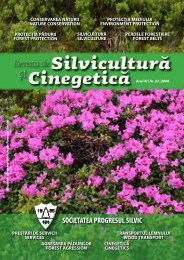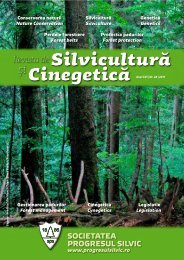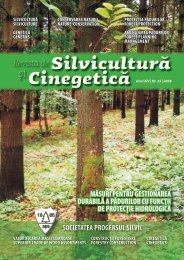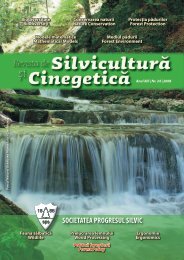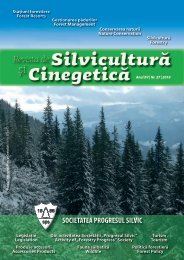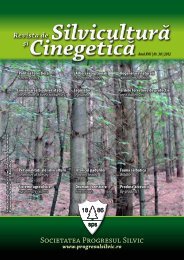Silviculture and Cinegetics Review - Societatea Progresul Silvic
Silviculture and Cinegetics Review - Societatea Progresul Silvic
Silviculture and Cinegetics Review - Societatea Progresul Silvic
Create successful ePaper yourself
Turn your PDF publications into a flip-book with our unique Google optimized e-Paper software.
FORESTRY BELTS SILVICULTURE AND CINEGETICS REVIEW XVII/30/2012<br />
<strong>and</strong> Găgeşti), in site conditions similar to the<br />
aforementioned, black locust reached height of approx.<br />
10 m, at age 9-15 years <strong>and</strong> a functionality of approx.<br />
70% of the proposed parameters (due to the absence of<br />
help species <strong>and</strong> shrubs on marginal lines). In favorable<br />
sites its growth is very active. Maximum diameter <strong>and</strong><br />
volume increment is between 12 <strong>and</strong> 20 years (in the<br />
same site conditions, aged 25 years its production is<br />
similar to the oak’s aged 40 years). Its longevity is over<br />
100 years, but after age 35-40 years, vitality weakening,<br />
drying <strong>and</strong> culture thinning was noticed (Photo 5).<br />
It sprouts <strong>and</strong> suckers strongly. It has lateral spreading<br />
roots on shallow soils, <strong>and</strong> tap-lateral spreading on deep<br />
soils, capitalizing very well the soil.<br />
The field protection belts installed after 1989, especially<br />
in the Siret Plain (at Măicăneşti, Tătăranu, Garoafa <strong>and</strong><br />
Doaga—Vrancea County), width of 8-12 m, were<br />
usually made of black locust, in the central corridor (2 x<br />
2 m scheme) <strong>and</strong> black locust, oleaster <strong>and</strong> dog rose (in<br />
equal proportions), in the outer lines (at 1 m/line). After<br />
the age of 10 years these forest belts become thin <strong>and</strong><br />
very penetrable (Photo 6), oleaster <strong>and</strong> dog rose (in the<br />
outer lines) are invaded by the black locust <strong>and</strong> even<br />
disappear, <strong>and</strong> the oleaster bends down a lot (4-6 m)<br />
disrupting neighboring crops.<br />
Photo 5. 50 years old Black locust, Perieni - Bârlad<br />
Photo 6. Black locust forest belt on cambic chernozem in<br />
silvosteppe, rare in lower part due to lack of bush <strong>and</strong><br />
secondary species (Garoafa, Vrancea)<br />
Consequently, since the black locust plantations grow<br />
thin <strong>and</strong> open with age, it is necessary on the outer lines<br />
locust no longer be used, but at most, some second size<br />
species (osage-orange, cherry-plum, Tartarian maple,<br />
field maple, oleaster, etc.), mixed with shrubs<br />
(hawthorn, dog rose, elder, red dogwood, privet, etc.).<br />
These may ensure regulation of the forest belt‘s<br />
penetrability <strong>and</strong> the soil’s protection. In this way it is<br />
also ensured both the belt protection against animals<br />
<strong>and</strong> the limitation of the locust’s <strong>and</strong> oleaster’s<br />
expansion / impact in the agricultural field. The shrubs<br />
gradually exp<strong>and</strong> through natural regeneration within<br />
the forest belt (under locust), with increasing degree of<br />
illumination at ground level with age.<br />
On compact, heavy or clay soils, or having a high<br />
content of calcium carbonate, those with temporary<br />
flood water, or salty soils, black locust did not give<br />
satisfactory results.<br />
Honey locust (Gleditschia triacanthos), was commonly<br />
used for the field <strong>and</strong> road protection belts, especially in<br />
the pre-marginal lines. Like the black locust, it has a<br />
pronounced open character. Although it prefers loose,<br />
wet soils, it grows satisfactorily on compact soils with<br />
calcium carbonates <strong>and</strong> even on those with a low degree<br />
of salinization (Photo 7). It led to good results on<br />
alluvial soils or protosoils, supporting well short floods.<br />
Its growth is rapid, although the first two years it is<br />
affected by sprout biting off produced by hare.<br />
38



